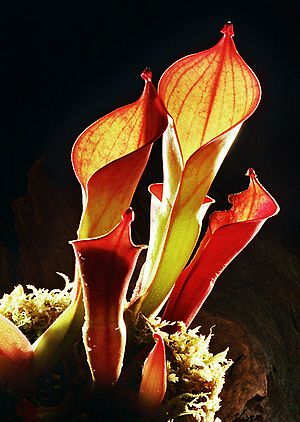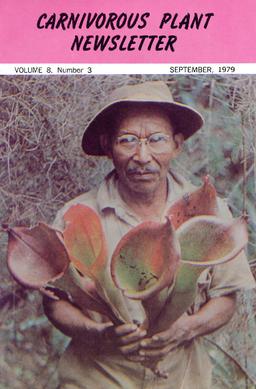Heliamphora ionasi facts for kids
Quick facts for kids Heliamphora ionasi |
|
|---|---|
 |
|
| Scientific classification | |
| Genus: |
Heliamphora
|
| Species: |
ionasi
|
| Synonyms | |
|
|
Heliamphora ionasi is a fascinating type of carnivorous plant known as a marsh pitcher plant. It is famous for having the largest pitchers of any plant in its group, called the Heliamphora genus. This amazing plant is found only in one special place in the world: a high plateau in Venezuela.
Contents
What is Heliamphora ionasi?
Heliamphora ionasi is a member of the pitcher plant family. Like other pitcher plants, it has special leaves that form a tube or "pitcher." These pitchers are used to trap insects, which the plant digests to get extra nutrients that are missing from the soil where it lives.
A Giant Among Pitcher Plants
This isn't your average pitcher plant! Heliamphora ionasi is a record-breaker. Its pitchers can grow up to 50 centimeters (about 20 inches) tall. That's almost as tall as a bowling pin! This makes it the largest known species in the entire Heliamphora genus.
Where Does It Live?
You can't find this plant just anywhere. It is endemic to a specific area in South America. This means it only grows naturally in one location on Earth. Its home is a high, flat-topped mountain, called a tepui. It grows on the plateau that connects two larger mountains known as Ilu Tepui and Tramen Tepui in Venezuela. This unique and isolated environment is the only place Heliamphora ionasi has ever been found.
The Story of Its Discovery
The plant was officially discovered and described for science in 1978. The discovery was made by a team of explorers led by a botanist named Bassett Maguire.
How the Plant Got Its Name
Have you ever wondered how plants get their scientific names? The second part of the name, ionasi, was chosen to honor Jonah Boyan, who was one of the key members of Maguire's team. The name ionasi is a Latin version of his first name, Jonah. It's a special way for scientists to remember the people who helped make important discoveries.
A photograph of Jonah Boyan holding a sample of the giant pitcher plant was even featured on the front cover of the September 1979 issue of the Carnivorous Plant Newsletter. This helped share the news of this amazing new plant with the world.
See also
 In Spanish: Heliamphora ionasi para niños
In Spanish: Heliamphora ionasi para niños


